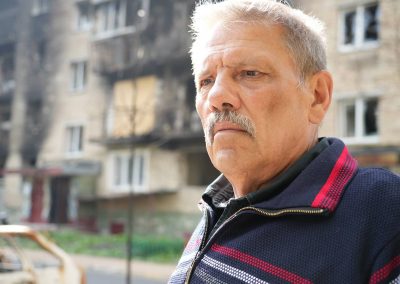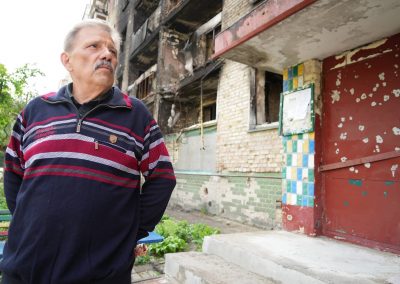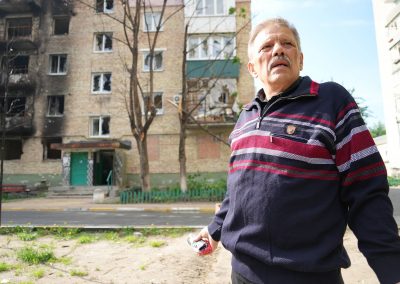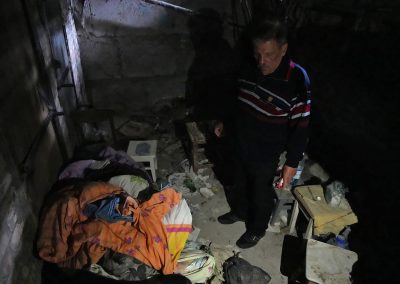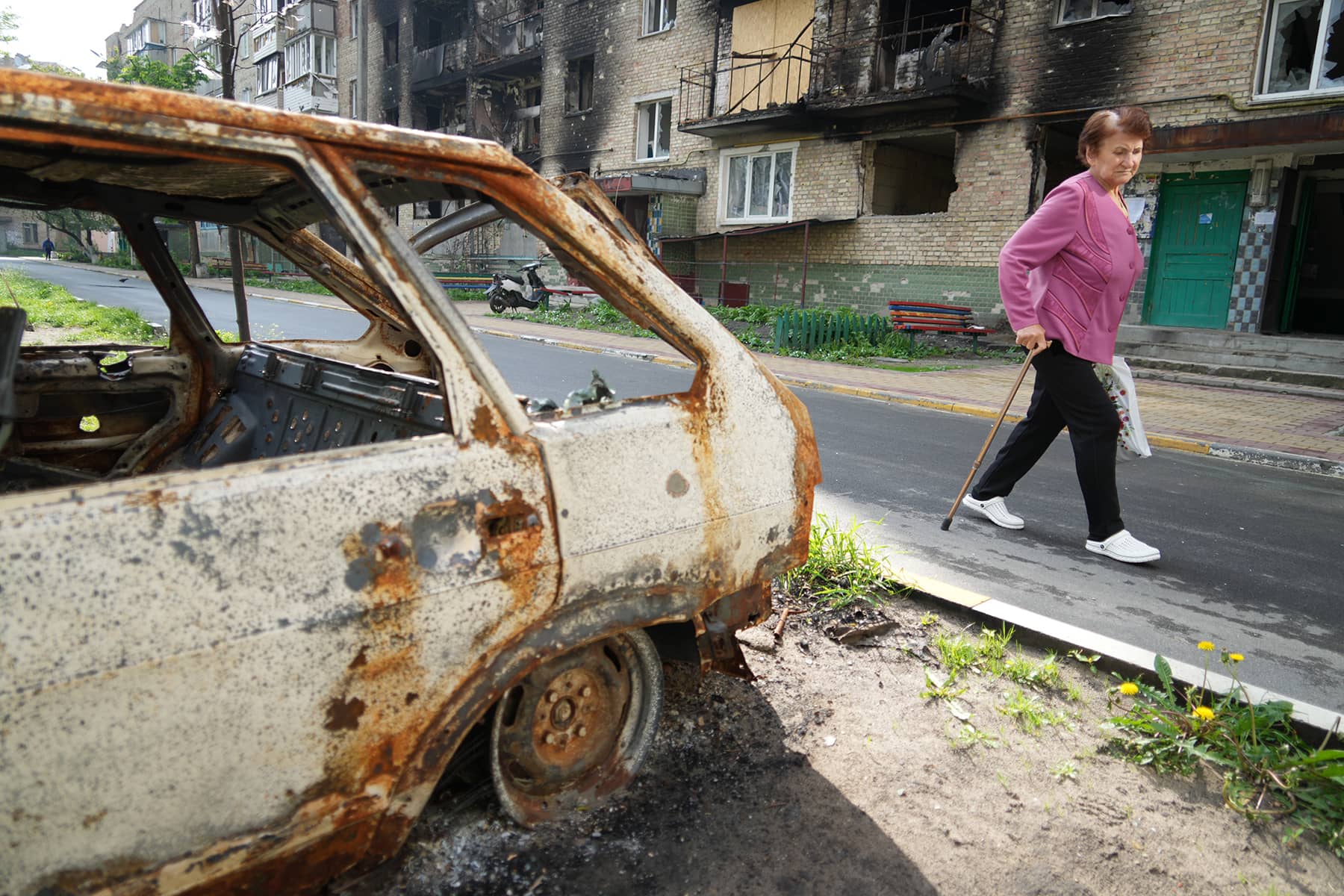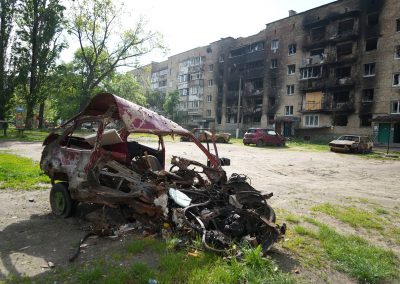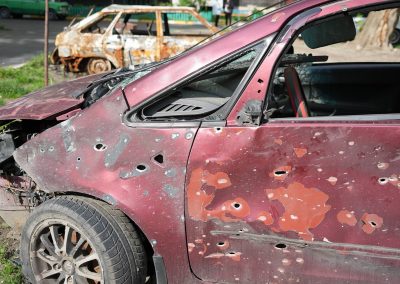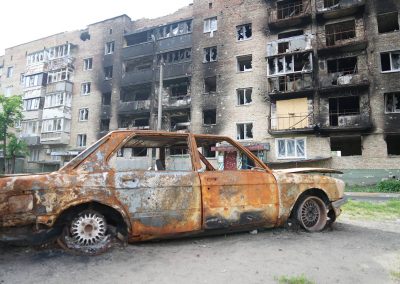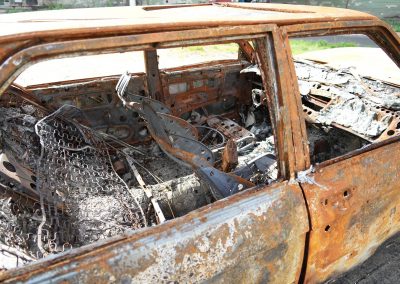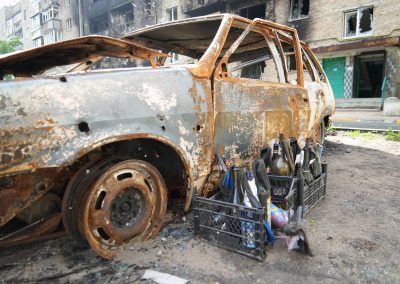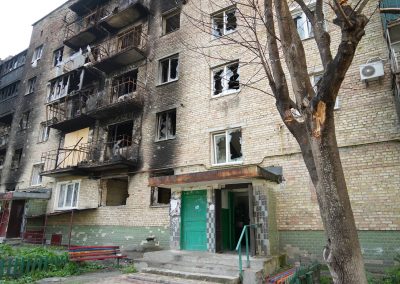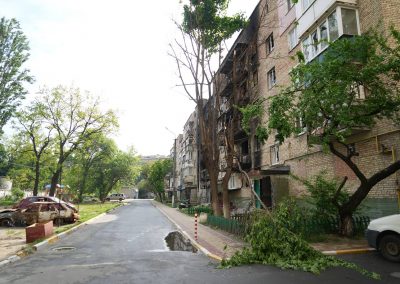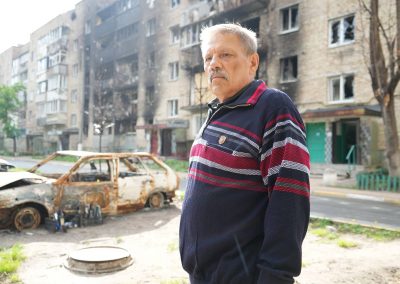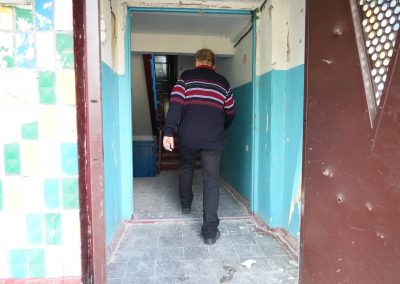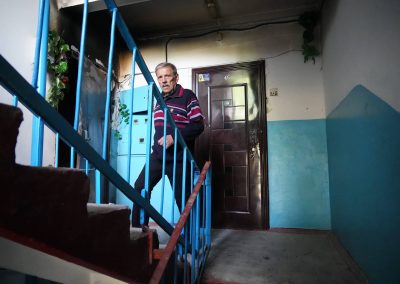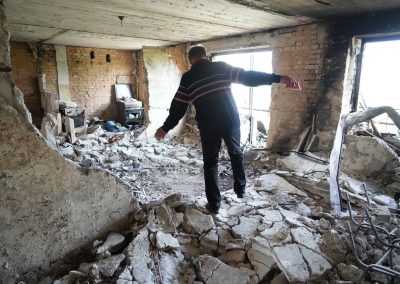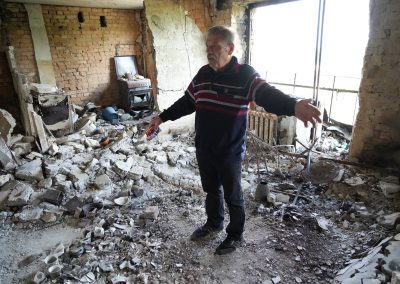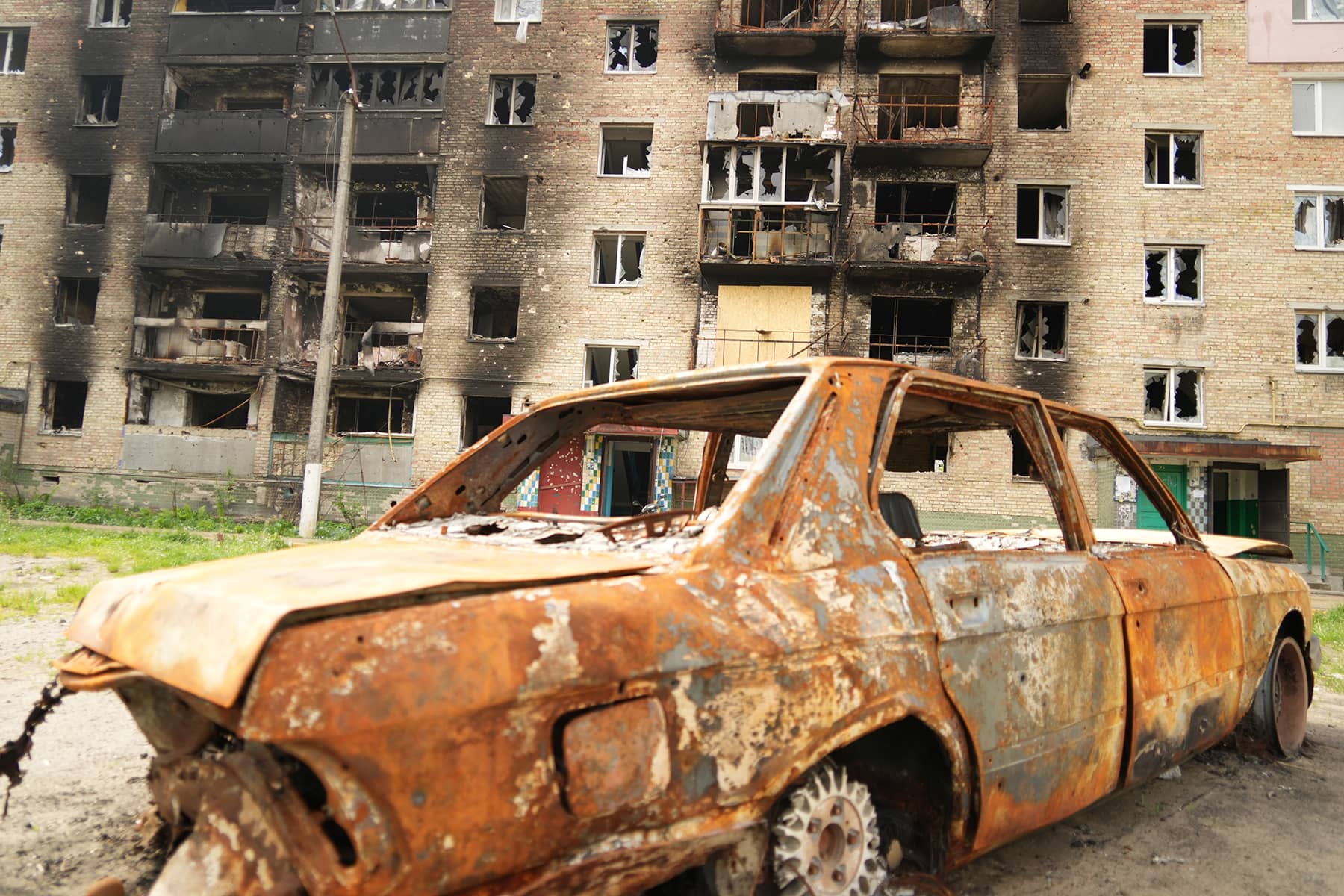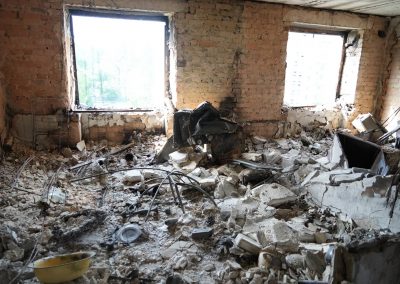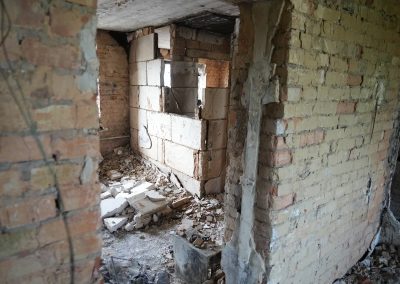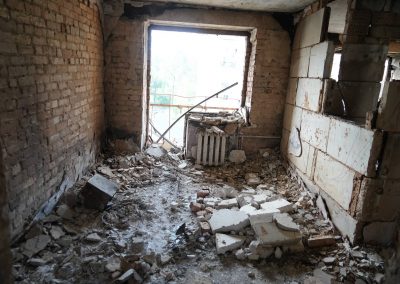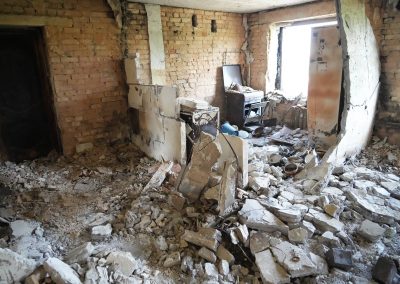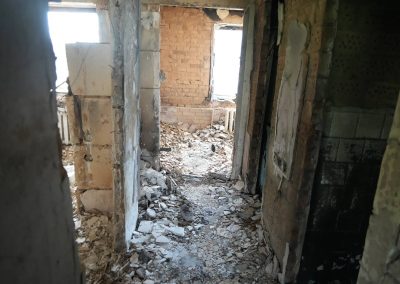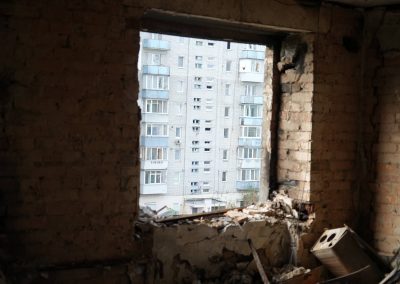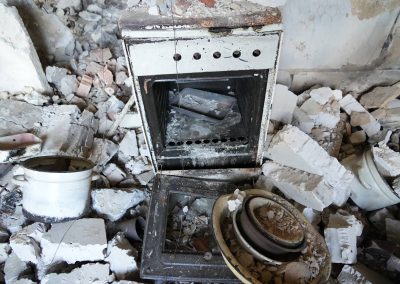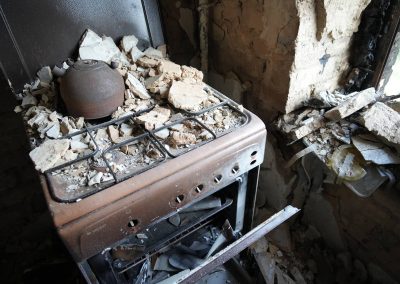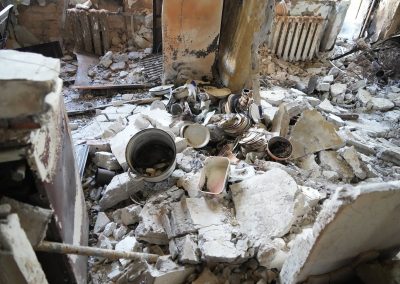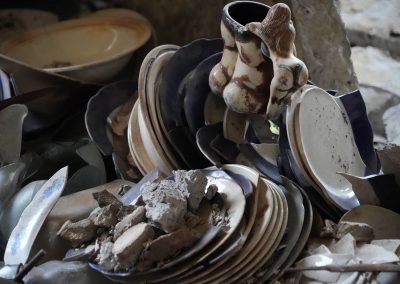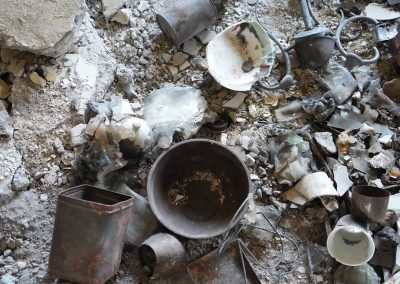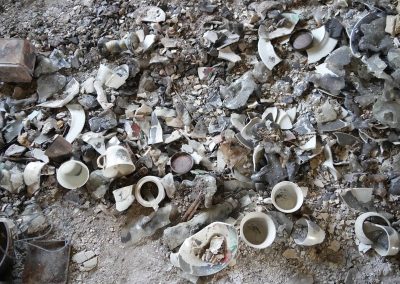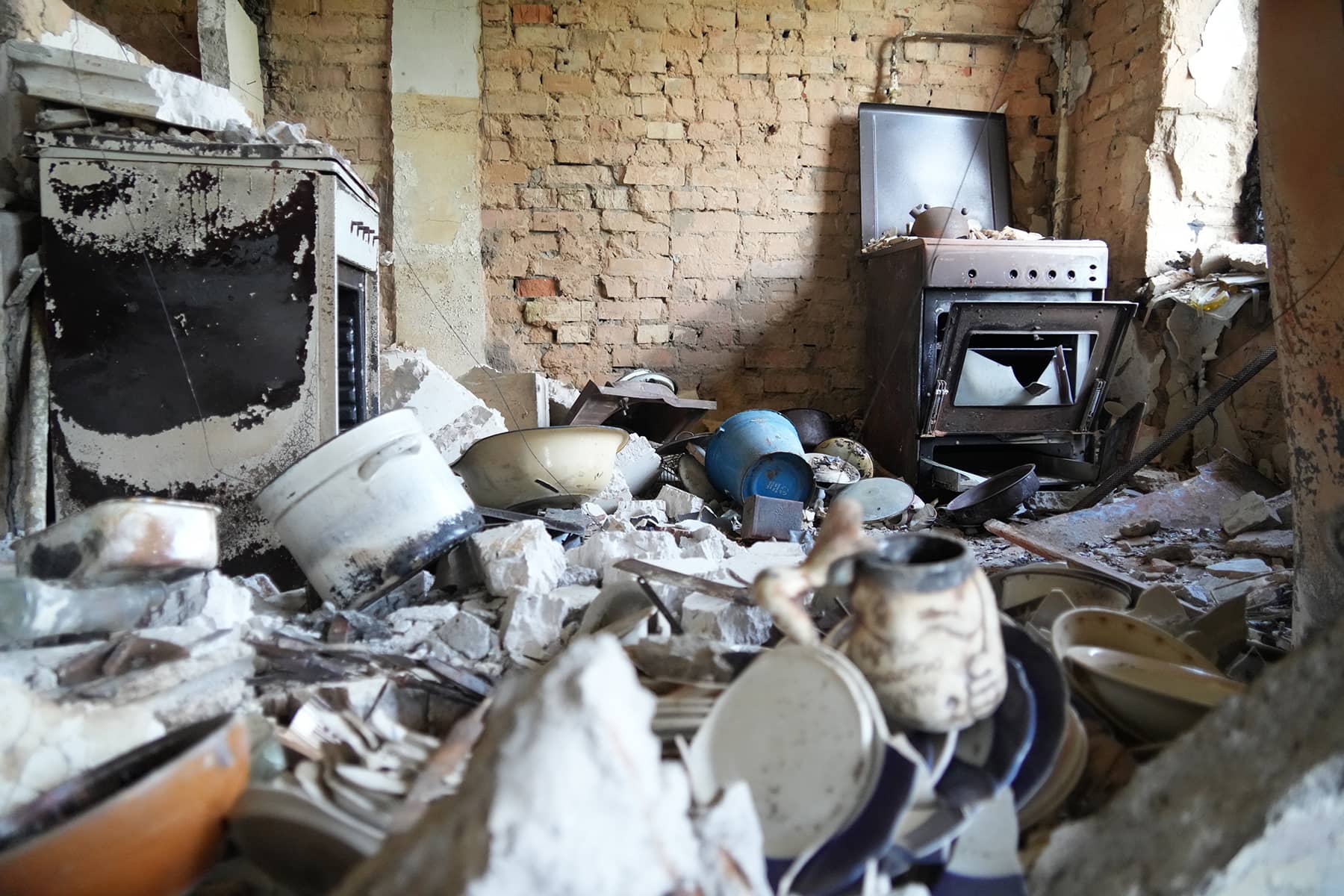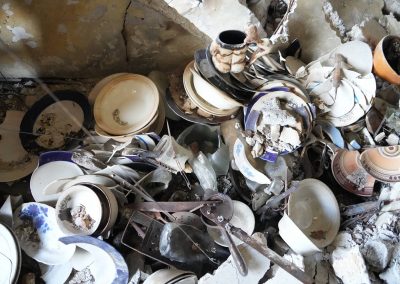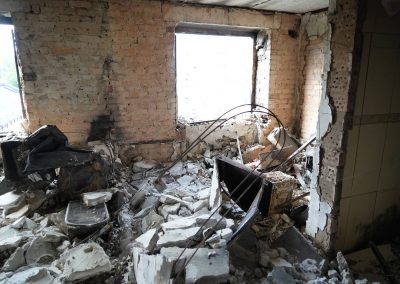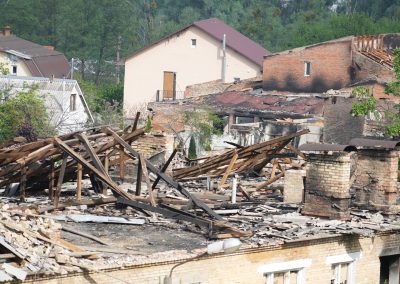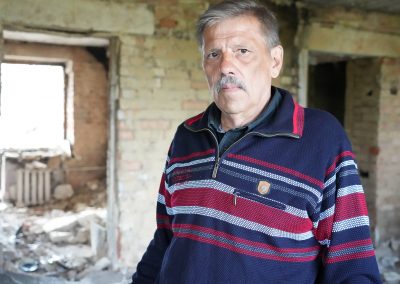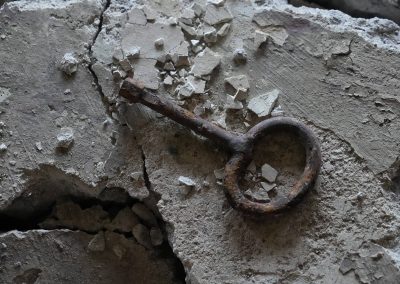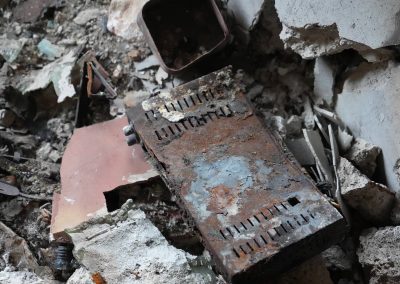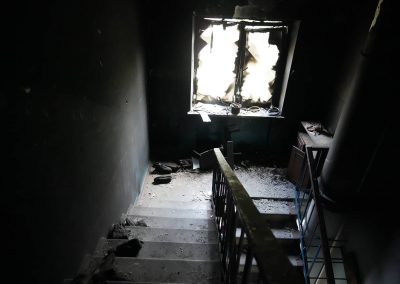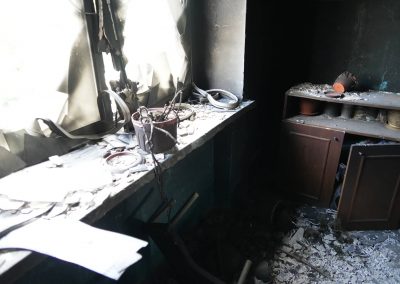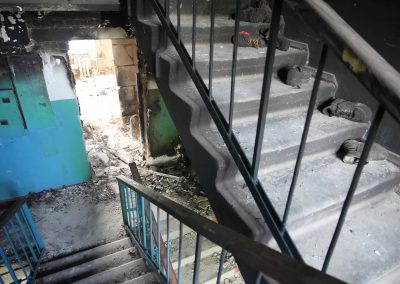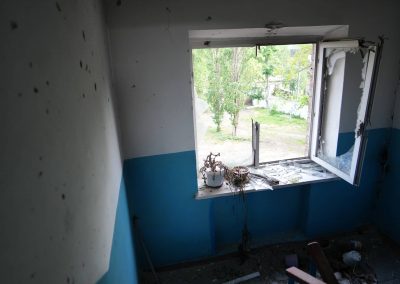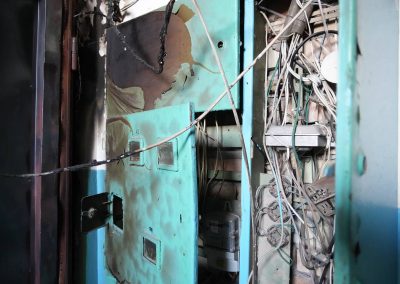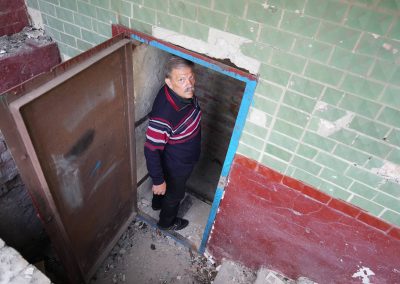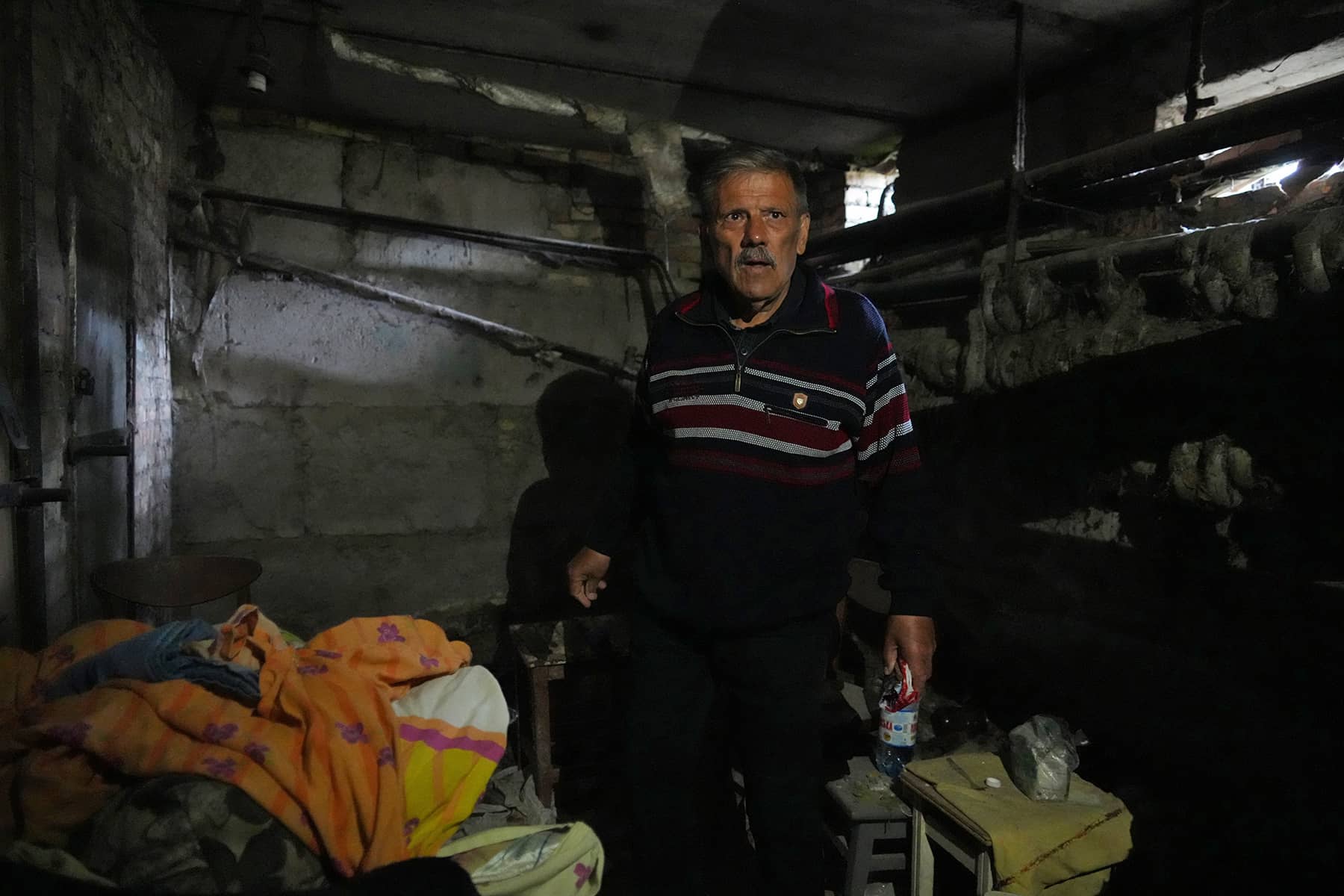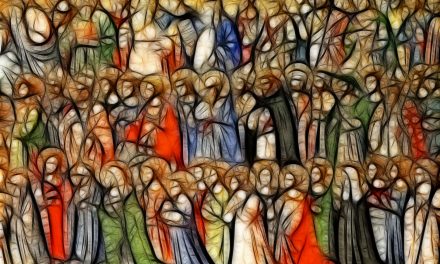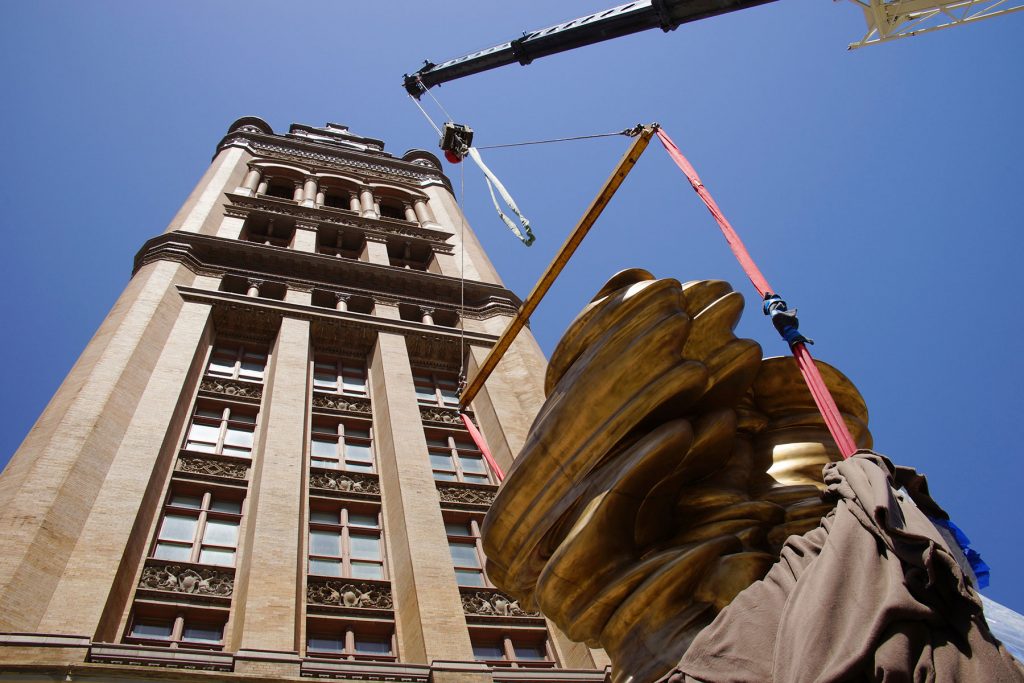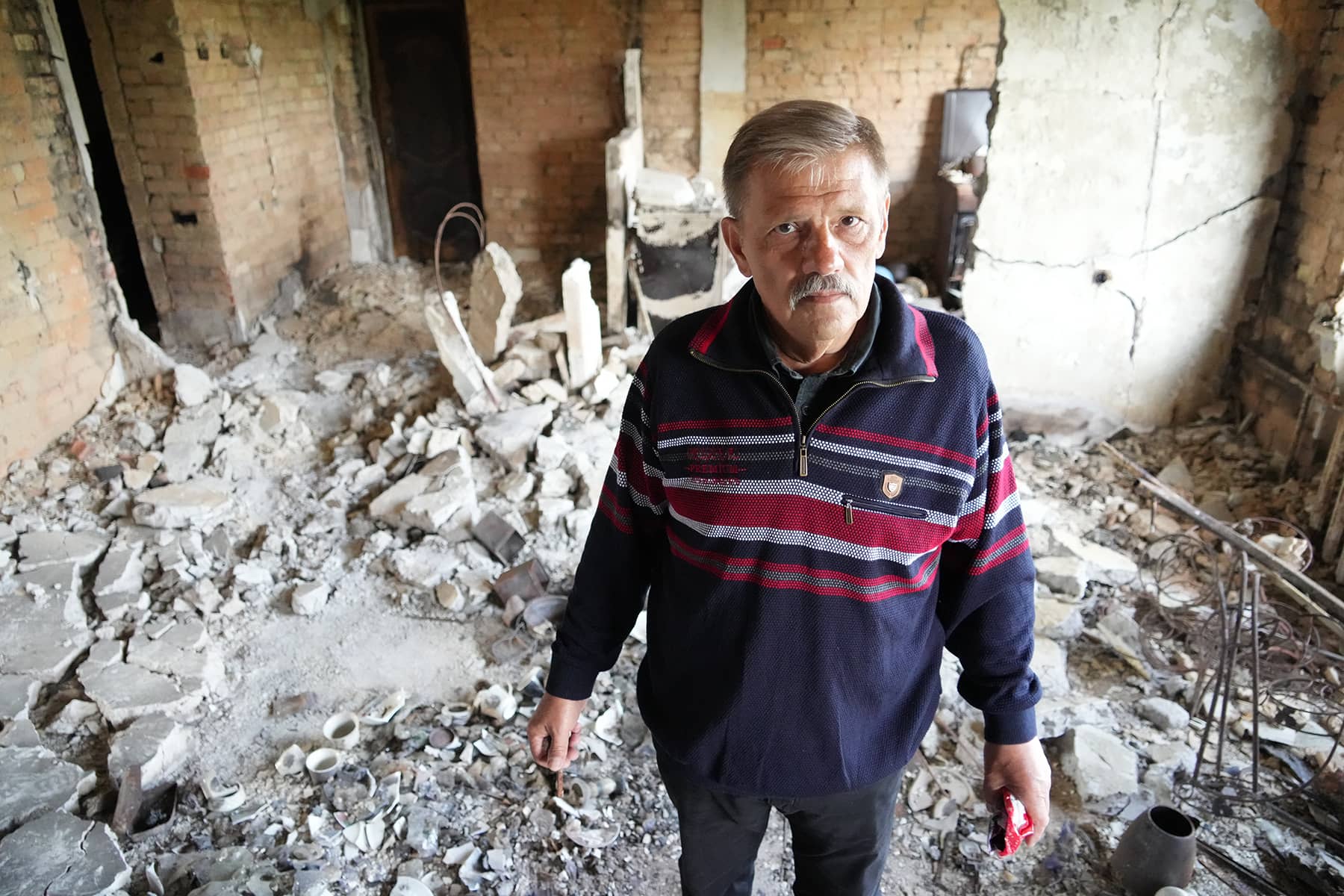
Elevated to the status of Hero City, the Battle for Irpin was a turning point in stopping the Putin’s invasion. The battle-worn town now stands as an example of resistance, and symbol of Russian defeat. But in the early days of the war, hardship and uncertainty gripped the residents of the Kyiv suburb who were unable to flee.
Most of the 60,000 people who lived in the middle class commuter city had escaped the brutal Russian bombardment, as military forces advanced through the bordering town of Bucha. But for several thousand residents, particularly the elderly without the resources or stamina to travel, finding shelter against the onslaught was their only option.
Near the edge of Irpin, a few blocks from a destroyed hospital and the city’s cultural center, stood the ruins of a shopping center and adjacent neighborhoods. It was a critical junction that connected the suburban city of Bucha to Irpin, and the road on to the capital city – the prize sought by Russia’s dictator – to take control of the independent nation.
But as the Russian invaders made their push to Kyiv, they became bottlenecked on Soborna Street, and faced fierce resistance from Ukrainian forces. A savage battle rattled the area, where in a building nearby lived a widower named Vasil.
The Milwaukee Independent team was surveying the area when the 69-year-old approached us to share his experience of surviving the invasion.
“I live here on the fifth floor. My dog was pawing to get out of the building. She felt something was wrong. I had just left the building, and within three minutes the explosion came. If I would have stayed, I would have died. My dog obviously knew something was about to happen,” said Vasil. “It all happened in front of my eyes on February 28th. I was standing here outside in the courtyard, and then I heard the explosion. The blast hit the tree and then it hit the second floor. There were flames everywhere, and that was how the fire started that engulfed the building. It was so hot that there were areas that melted.”
The burnt husks of two cars remained in the building’s courtyard, one damaged from the initial explosion on February 28, the other caught fire on March 14, when it was hit by a landmine that had been detonated by a mortar shell. Despite finding a war on his front steps, Vasil tried to go about his life as usual.
“In those early days, I would go out and walk my dog. I was always walking around,” said Vasil. “It was shelling all the time. There were shells landing here, shells hitting there. I wasn’t afraid. Whatever happens will happen, I thought. God will save me. I was walking around because the cellar where I took shelter was dark and without electricity. And there was a lot of dust.”
When a Russian artillery shell hit the second floor of his building, no one was living in that space at the time. Vasil’s wife had died from cancer before the war, so he found himself alone when the Russians came.
“That’s why I stayed. There was no one to help me. I used to work at the local brick factory, so my pension is low. I’ve been able to get some canned food from the church, but it is hard to prepare with my building destroyed,” said Vasil. “Right now, I live a couple days with some people, a few days with other people. I am kind of wandering around. I was offered to live in a tent, but I didn’t like it. People were smoking, people were drinking. I don’t do either, so how am I to live with them? I was afraid that people might steal my things. Where families live, those areas are fine, but I don’t belong. It’s not for me.”
Vasil said that there were times when he had no mobile phone reception. So he would have to go up a hill to get a signal, or ask a neighbor in an undamaged building to use their landline. He also said that Russian soldiers never made it the few blocks up Soborna Street, but they did capture part of Irpin on March 6.
“We were hard hit because the Territorial Defense fought back and wouldn’t let them enter Irpin. Our soldiers were here with cannons, defending us and the neighboring village. That was why this area took so much damage, because the Russians were trying to hit them,” said Vasil. “But even after our troops left the area, the Russians kept shelling us. They were trying to hit civilians. I would hear the bam bam bam of shelling for two hours straight sometimes.”
Vasil showed us the shattered ruins of his home, reduced to rubble. Among the debris were a few surviving objects. We then followed him downstairs to the building’s cellar, where he remained hidden for about month.
It was where he and his dog slept. Because there was no heater, Vasil would keep his pet next to him for warmth. The only way he could keep track of time was if light came in, letting him know it was morning. With food in short supply, Vasil said that the Territorial Guard supplied him with meals for a while.
“I didn’t have a radio either, so if I saw a neighbor I would ask about what was happening. But they only stayed for the first couple weeks of the war, then everyone left,” said Vasil. “I didn’t have anywhere to go. And I only had 170 Hryvnia. So I couldn’t even afford transportation if I did.”
Only after Ukrainian troops recaptured the city on March 28 and liberated it from Russian occupation did Vasil abandon his underground shelter.
“I asked a government official if there was somewhere permanent to live, not the temporary housing, and they did not have a response. So I’ll wait until the fall. Maybe by then the war will be over and I’ll find a better place to live,” added Vasil.
© PHOTO NOTE: All the original editorial images published here have been posted to the Facebook page of Milwaukee Independent. That collection of photos contains the MI copyright and watermark for attribution, and may be used for private social media sharing. Do not download and share images directly from this page. mkeind.com/facebook
Series: Reports from Ukraine
- Reports from Ukraine: Traveling from Milwaukee to a country at war just to take a vacation from America
- Images from Ukraine: Latino artist travels to Irpin to paint mural inspired by "Echoes of Guernica"
- Images from Ukraine: Irpin residents welcome reissue of Russian Warship Stamp as latest sign of victory
- Stories from Ukraine: Wandering in the ruins of a shattered life after surviving Russia's invasion
- Images from Ukraine: Similar to the Alamo, martyred cities bought precious time to save a nation
- Stories from Ukraine: Tent camp offers shelter for displaced residents until Irpin can rebuild lost homes
- Images from Ukraine: Graveyards of Russian war machines show the scale of Putin's failure to seize Kyiv
- Images from Ukraine: Following the invasion convoy's 40-mile route and exploring an abandoned base
- Stories from Ukraine: Illegal weapons and proof of Russian War Crimes easily seen along streets of Irpin
- Images from Ukraine: How Irpin’s cemetery processed the staggering massacre of its local citizens
- Stories from Ukraine: Healing remains slow as Borodyanka residents recover from occupation
- Images from Ukraine: The deep scars of war remain visibly etched across the landscape of Borodyanka
- Interview with Oleksandr Markushin: Mayor of Irpin and the hero of a Hero City
- A Meeting of Sister Cities: Former and current Mayors of Irpin ask Milwaukee's business community for help
- Stories from Ukraine: Having a shared purpose helped Irpin's leaders protect the city and stop the invaders
- Stories from Ukraine: How Milwaukee helped a bakery feed hungry survivors in Bucha with fresh bread
- Stories from Ukraine: Bucha resident recalls how Russians turned neighborhood into a street of death
- Stories from Ukraine: How a mass grave of executions overshadowed accountability from Bucha’s leadership
- Images from Ukraine: Putin’s attack on Babyn Yar is a painful reminder of the broken vow of “Never Again”
- Images from Ukraine: An unexpected encounter with Jewish history and the bloody legacy of persecution
- Images from Ukraine: Listening to timeless voices of ethnic heritage etched in stone at Lychakiv Cemetery
- Images from Ukraine: The experience of attending a military funeral in Kyiv while children died in Uvalde
- Images from Ukraine: Stepping out of the fog of war to see the beauty of faith in ancient places of worship
- Images from Ukraine: The cities of Kyiv and Lviv were divided by history but remain united in identity
- Stories from Ukraine: Anya Nakonechna shares why the Lviv Opera is a symbol of her nation’s culture
- Images from Ukraine: A folk village where visitors can experience the life of past generations
- Images from Ukraine: Signs of renewal sprout from under Irpin’s rubble as city looks to the future
Oleh Pinta
Oleh Pinta and Halyna Salapata
Lее Mаtz
Milwaukee Independent editorial team for this special series: (UKRAINE) Lee Matz, photojournalist; Oleh Pinta, translator / reporter; Yaroslav Zdyrko, security / videographer; (MILWAUKEE) Halyna Salapata, logistics / translations.
Milwaukee Independent has reported on the situation in Ukraine since it was invaded on February 24. Coverage originally began with reactions and rallies from the local Ukrainian American community, and relationships with Milwaukee’s sister city of Irpin. Through partnerships and good journalism, sources were developed that enabled Milwaukee Independent to publish developments about the unprovoked war in realtime. In late May, a team from Milwaukee Independent spent nearly two weeks on the ground in Ukraine. The award-winning daily news magazine was the first and, at the time, only media organization to send staff into the country since the war began.
Reports from Ukraine: An extensive news series by Milwaukee Independent from a country at war

